Description
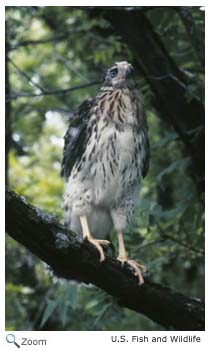 Cooper's hawk is a medium-sized hawk 15-20 inches in length with a wingspan of 24-35 inches. It has a long, rounded tail with gray and black bars and a white band at the tip; short, rounded wings; red eyes; and yellow legs. It is grayish-brown on its back and wings and white with reddish-brown streaks on its breast and belly. Males and females look alike, although the female can be 1/3 larger than the male. Cooper's hawk is a medium-sized hawk 15-20 inches in length with a wingspan of 24-35 inches. It has a long, rounded tail with gray and black bars and a white band at the tip; short, rounded wings; red eyes; and yellow legs. It is grayish-brown on its back and wings and white with reddish-brown streaks on its breast and belly. Males and females look alike, although the female can be 1/3 larger than the male.
Range 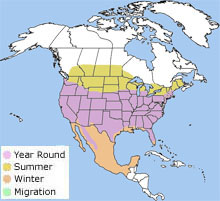 Cooper's hawk breeds
across southern Canada south to Mexico.
It winters in the United States and Mexico.
Cooper's hawk is found in New Hampshire. Cooper's hawk breeds
across southern Canada south to Mexico.
It winters in the United States and Mexico.
Cooper's hawk is found in New Hampshire.
Habitat
Cooper's hawk is found in forested areas. It prefers deciduous forests with open areas, but it is also found in mixed forests and coniferous forests. It is also found in urban and suburban areas with tall trees. | |
Diet
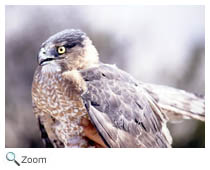 Cooper's hawk eats
medium-sized birds and small mammals. It stalks its prey, staying hidden by forest cover. It flies close to the ground, stalking and chasing its prey through the trees. It
captures its prey with its feet and then squeezes the prey to kill it. Cooper's hawks also drown their prey by holding it underwater. Flying through the forest after prey is a dangerous way to get your food, and many cooper's hawks injure themselves! Cooper's hawk eats
medium-sized birds and small mammals. It stalks its prey, staying hidden by forest cover. It flies close to the ground, stalking and chasing its prey through the trees. It
captures its prey with its feet and then squeezes the prey to kill it. Cooper's hawks also drown their prey by holding it underwater. Flying through the forest after prey is a dangerous way to get your food, and many cooper's hawks injure themselves!
Life Cycle
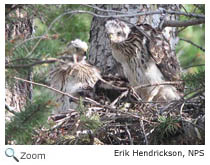 The male cooper's hawk may court the female for up to a month before mating. Both the male and female Cooper's hawk build a nest in a tree 20-50 feet above the ground. The nest is an open bowl of sticks and twigs and is sometimes lined with bark and vegetation. The female lays 3-5 eggs
and the male brings food to the her while she is incubating the eggs. The male incubates the eggs when the female has to leave the nest. The eggs hatch in 30-33 days. The male continues to bring food to the nest for the female. The female then feeds the chicks. The chicks fledge when they are about five weeks old and continue to be fed by the female for another two weeks. The male cooper's hawk may court the female for up to a month before mating. Both the male and female Cooper's hawk build a nest in a tree 20-50 feet above the ground. The nest is an open bowl of sticks and twigs and is sometimes lined with bark and vegetation. The female lays 3-5 eggs
and the male brings food to the her while she is incubating the eggs. The male incubates the eggs when the female has to leave the nest. The eggs hatch in 30-33 days. The male continues to bring food to the nest for the female. The female then feeds the chicks. The chicks fledge when they are about five weeks old and continue to be fed by the female for another two weeks.
Behavior
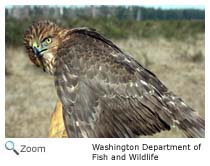 The Cooper's hawk population, especially in the eastern United States, was greatly reduced in the mid-twentieth century due to the use of the pesticide DDT. DDT, which was used to control the insects that damaged crops, was getting into the food that the Cooper's hawk ate. The pesticide made it more difficult for the Cooper's hawk to absorb calcium, and the lack of calcium made the shells of the Cooper's hawk's eggs thinner. Many eggs broke before they could hatch, and the Cooper's hawk population declined. DDT use was outlawed in the U.S. in 1972, and the Cooper's hawk population has slowly recovered. The Cooper's hawk population, especially in the eastern United States, was greatly reduced in the mid-twentieth century due to the use of the pesticide DDT. DDT, which was used to control the insects that damaged crops, was getting into the food that the Cooper's hawk ate. The pesticide made it more difficult for the Cooper's hawk to absorb calcium, and the lack of calcium made the shells of the Cooper's hawk's eggs thinner. Many eggs broke before they could hatch, and the Cooper's hawk population declined. DDT use was outlawed in the U.S. in 1972, and the Cooper's hawk population has slowly recovered. |



 Cooper's hawk breeds
across southern Canada south to Mexico.
It winters in the United States and Mexico.
Cooper's hawk is found in New Hampshire.
Cooper's hawk breeds
across southern Canada south to Mexico.
It winters in the United States and Mexico.
Cooper's hawk is found in New Hampshire. 

